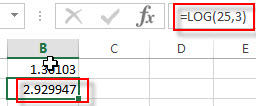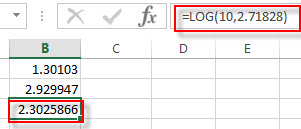This post will guide you how to use Excel LOG function with syntax and examples in Microsoft excel.
Table of Contents
1. Description
The Excel LOG function returns the logarithm of a given number based on a supplied base. And the default base argument is 10.
The LOG function is a build-in function in Microsoft Excel and it is categorized as a Math and Trigonometry Function.
The LOG function is available in Excel 2016, Excel 2013, Excel 2010, Excel 2007, Excel 2003, Excel XP, Excel 2000, Excel 2011 for Mac.
2. Syntax
The syntax of the LOG function is as below:
= LOG (number,[base])Where the LOG function arguments are:
- number – This is a required argument. The number that you want the logarithm. And the number must be a positive real number.
- Base – This is an optional argument. The base of the logarithm. If the base is omitted, the base argument will be set to 10.
Note:
- If either the supplied number argument or base argument is negative or zero, the LOG function will return #NUM! Error.
- If the base argument is equal to 1, the LOG function will return #DIV/0! Error.
- If the number argument or the base argument is non-numeric, the LOG function will return #VALUE! Error.
3. Excel LOG Function Examples
The below examples will show you how to use Excel LOG Function to calculate the logarithm of a given number, to a supplied base.
1# to get the logarithm of 20, and using the default base argument, enter the following formula in Cell B1.
= LOG(20)
2# to get the logarithm of 25 with base 3, enter the following formula in Cell B2.
=LOG(25,3)
3# to get the logarithm of 10 with base e (2.71828), enter the following formula in Cell B2.
=LOG(10,2.71828)
4. Video: Excel LOG Function
This Excel video tutorial, we’ll explore how to calculate logarithms with different bases using the Excel LOG function.
5. Related Functions
- Excel LOG10 function
The Excel LOG10 function returns the base-10 logarithm of a given number.The syntax of the LOG10 function is as below:= LOG10 (number)… - Excel LN function
The Excel LN function returns the natural logarithm of a given number. And the natural logarithms are based on the constant e (the value is equal to 2.718281828…). The syntax of the LN function is as below:= LN (number)…
Leave a Reply
You must be logged in to post a comment.